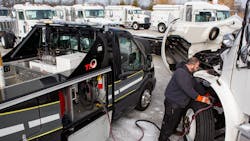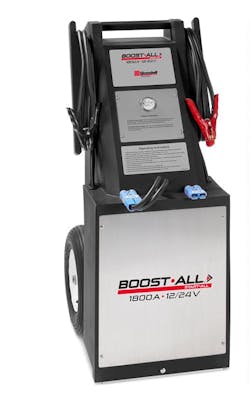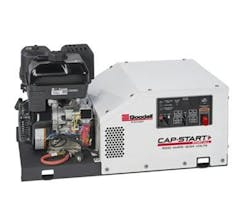When batteries fail to provide sufficient starting power, the immediate result is a loss in vehicle and worker utility. If the wrong method of jump-starting is employed, the impact on man and machine can be much more serious.
Batteries have a finite life span and will ultimately fail over time. However, by selecting and deploying the most appropriate method of boosting them, smart fleet maintenance professionals can keep their vehicles and workers safely moving and their batteries functioning.
Let’s start by dispelling some myths and reviewing some mitigating factors, then move on to my favorite topic — solutions.
What exhausts the battery?
A lot of folks think that winter kills batteries, but that’s not really accurate. In reality, the warmer months often fatally injure batteries; the colder ones finish them off.
Last-mile delivery duty cycles, hydraulic equipment, hotel loads, and parasitic electrical equipment can deplete batteries far beyond an alternator’s ability to replenish them. The batteries never fully recover and get weaker and weaker. When the weather gets colder, the engine’s fluids get more viscous, and the starter asks for more than the battery has left to give.
Operator error also plays a significant role in battery failure, a fact that often gets overlooked. Operator behaviors such as forgetting to turn off the lights or overworking an engine-off vehicle at a jobsite can result in significant battery replacement costs. Additionally, vehicle batteries working overnight at truck rest stops further place a strain on budgets due to similar oversights.
The number one reason for a “no start situation,” meaning the vehicle will not crank over and start on its own, is operator mistreatment of the battery. So, my first recommendation is to promote battery health awareness to operators.
Jumping to conclusions
We’ve all heard the stories about jump-starts resulting in catastrophic outcomes. However, it’s typically not due to jump-starting but to a cracked or damaged battery. Other possibilities include using an outdated jump system, reversing the polarity when hooking up the cables, or applying the wrong voltage. Let’s face it—the technician sent out to the yard to jump a vehicle may not be the most seasoned repair veteran.
Done correctly with the proper equipment, though, jump-starting isn’t dangerous nor will it damage onboard electronics. If you use best practices and if the jumping equipment is up to date and its voltage is protected, jump-starting is not an unsafe practice in any temperature.
Jump-starting methods
Now, let’s explore the key differences between jump-starting methods, when each one is most appropriate, and what to watch out for.
Vehicle-to-vehicle is the most basic form of jump-starting. All you need is a pair of jumper cables and two vehicles with matching voltage, and you’re all set. Because it’s still possible for a novice to connect cable clamps to the wrong poles, make sure your jumper cables are the newer polarity-protected type. A range of polarity-protected, plug-to-plug jumper cables with a variety of cable gauges are available. I also recommend an Antizap surge protector that shields delicate electronics from transient voltage spikes or voltage surges, which is available from Vanair.
Read more: 5 battery testing basics you should know
It’s best to use the V2V method in non-urgent situations where traffic is not an issue. This allows you to safely position the two vehicles in optimum orientation for cables to reach and clamp on to the correct battery terminals.
This method offers low equipment costs, and the cables last multiple years if stored correctly. The downsides are lower volume capabilities, more time, and higher labor costs.
Another option is the mobile battery cart, which typically comprises traditional Group 31 or AGM lead-acid batteries on a wheeled cart delivered to the downed asset via another vehicle. Keep in mind that mobile carts have a finite amount of power to lend out before needing a recharge themselves.
This option is appropriate for a low volume of vehicles, as they can only provide a handful of jumps before being tapped out. These carts are an essential tool for any shop, and if correctly engineered, their 12-volt batteries will be wired to start both 12- and 24-volt equipment.
These also have a low to moderate equipment cost, and like V2V, they have low volume capabilities and higher time and labor costs. The anticipated equipment life expectancy for mobile battery carts is three to five years.
The performance of lithium-ion battery-based jump packs is far superior to any Group 31 lead-acid counterpart. They are lightweight, high-performance energy storage systems with the capacity to start many more vehicles sequentially before needing to be recharged. These power-dense engine starting tools come in a broad range of sizes. Vanair offers its Goodall brand, Start•All Lithium-Ion Jump Starters and Power Packs in capacities ranging from 2,500 amp, 12-volt, 333,000 joules all the way up to 10,000 amp, 12/24-volt, 166,500 joules. Rugged and compact, these handheld devices can fit in tight spaces.
Li-ion packs are versatile and boast high-volume vehicle starting capabilities. Smaller versions are perfect for starting 6-liter gas and 4-liter diesel engines on passenger vehicles. Larger versions are powerful enough to jump-start 16-liter diesel semis, buses, construction equipment, and agricultural equipment.
These cost more than Group 31 lead-acid, battery-based devices but have far higher volume capabilities from a single unit. They also take less time per jump and thus produce lower labor costs. There are many options available based on style, capacity, and price point, so fleets can choose the best fit for their needs. Anticipated equipment life expectancy is two to three years.
Read more: The latest in battery testing and starters
Supercapacitors reliably deliver powerful cold-cranking amps for up to 1 million cycles. They are capable of delivering 12- and 24-volt starting power whether the ambient temperature is as low as -40 degrees F (-40 degrees C) or as high as 149 degrees F (65 degrees C). Vehicle-mounted options are available and come in a variety of models, including compact battery-driven and hydraulically driven.
These are best suited for extreme, high-volume, financially driven situations. Let’s say you have 30 heavy-duty dozers in below–zero temperatures or 20 transit buses on a bone-chilling morning, all needing a jump. And if you’ve got a big excavator capable of generating tens of thousands of dollars in revenue per hour, every minute that vehicle doesn’t start loses you money, so you need the fastest and most powerful solution.
These, of course, have the highest equipment cost compared to all other forms of engine-starting technology. Higher volume capabilities and higher cranking power means less time spent per start, equaling the lowest labor cost. There are also several models, styles, capacities, and price points that can precisely meet a fleet’s needs. A major positive is that a supercapacitor’s life expectancy is 10 to 15 years, or 1 million cycles.
Final thoughts
Dead batteries are bound to happen, so it’s important to be ready for them. Whichever jump-starting method your fleet chooses to employ, please keep safety top of mind. And if you’re ever in doubt or have a question on this technology, reach out to me at [email protected], as I obviously love talking about this topic.
About the Author

Jeff Steer
Jeff Steer is the Strategic Sales Manager for Engine Starting, the Engine Driven Compressor, and Aftermarket Accessories at Vanair, he continues to expand the company’s customer base, develop its sales team, and equip both distributors and fleet customers with the knowledge and training they need to make informed product decisions.
He joined Vanair in 2017 as National Sales Manager following its acquisition of Goodall Mfg, where he had served in the same capacity since 2006. With over 20 years in the truck equipment industry, Steer has traveled extensively across the U.S. and Canada, fostering strong relationships and developing products that now complement Vanair’s Engine Starting Product Group.


